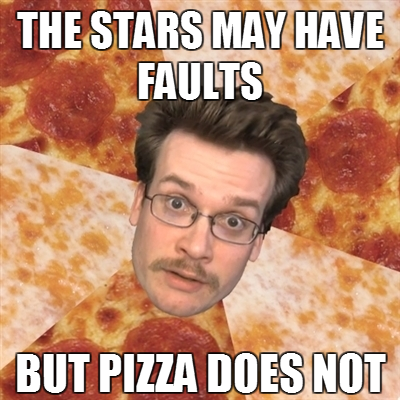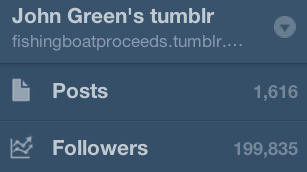 I’ll be honest: my ultimate goal when attending Book Expo America and Bookcon this year was to see John Green. Yes, me and thousands of other people, most of which were teenage girls. Of course, when I read John Green’s first book, Looking for Alaska, it was 2006 and I was fifteen years old, a teenage girl. Then, I didn’t know who the author was, nor was it really important. I only wanted to read a story about a girl named Alaska. However, I think this is still the goal today, despite the fact that authors can share their personal stories with thousands of people. Nonetheless, an author’s strong social media presence can have a lasting impact on the amount of people who choose to read their book. You can’t say John Green without immediately thinking of his latest and most popular novel, The Fault in Our Stars, and vice versa. Although my parents still ask, “It’s what? We are at fault for the stars?” Close enough. With The Fault in Our Stars releasing as a major motion picture this Friday, June 6, there is not a better time than now to present this special edition of the Link of the Week.
I’ll be honest: my ultimate goal when attending Book Expo America and Bookcon this year was to see John Green. Yes, me and thousands of other people, most of which were teenage girls. Of course, when I read John Green’s first book, Looking for Alaska, it was 2006 and I was fifteen years old, a teenage girl. Then, I didn’t know who the author was, nor was it really important. I only wanted to read a story about a girl named Alaska. However, I think this is still the goal today, despite the fact that authors can share their personal stories with thousands of people. Nonetheless, an author’s strong social media presence can have a lasting impact on the amount of people who choose to read their book. You can’t say John Green without immediately thinking of his latest and most popular novel, The Fault in Our Stars, and vice versa. Although my parents still ask, “It’s what? We are at fault for the stars?” Close enough. With The Fault in Our Stars releasing as a major motion picture this Friday, June 6, there is not a better time than now to present this special edition of the Link of the Week.

When it comes to using social media, authors do not necessarily have to put themselves out there as personally as John Green has in order to garner success. This February 2013 Huffington Post article, “Does Social Media Sell Books? Gillian Flynn’s Agent Gives Her Perspective,” sheds some interesting insight on the topic. Gillian Flynn is the bestselling author of Gone Girl. Her agent said in the article, “There has certainly been a lot of social media chatter ABOUT Gillian’s books, although it’s true that for the most part she was not out there participating in or generating the conversation. I think a lot of this was ignited by media coverage of the book (online and off) and early on it was helped by a widespread galley distribution that the publisher executed for Gone Girl. The book itself really encourages discussion, so as more people read it, more people felt compelled to talk about it.”

However, I also do not believe that John Green’s success is solely determined by his use of social media. No matter how socially popular an author becomes, the books need to have readability. Like in the case of Gone Girl, they need to be good. If his books weren’t any good, why would hundreds of thousands of people continue to be interested in his social media presence? I suppose it is possible to follow Green’s updates and videos based only on curiosity and interest in him as a person, but what fun would that be? John Green is an author first, and it is his storytelling talent that keeps readers wanting more. Knowing about an author on a personal level is more like an added bonus.

Nevertheless, the combination of John Green’s charismatic social media presence and the exponential love of his books has truly escalated him to the title of an author rockstar. Well, I personally don’t like the word “rockstar” to describe John Green. “Celebrity” isn’t necessarily the right world either. “Popular person” might be the right words. With social media, Green has shown that he is indeed just a person like his readers. The symbiotic relationship of traditional book marketing on Penguin’s part and social media digital marketing has become the perfect pairing for Green’s success. I think it is important for each individual author to do only what he or she is comfortable with in terms of social media. Authors should not have to force themselves to participate in social media. However, if an author is good at it, like Green, then it can be very beneficial.

A meme of Green’s Tumblr icon
In a May 2013 post from John Green’s Tumblr, Fishing Boat Proceeds, Green gave his opinion on the success of The Fault in Our Stars. He said, “The Fault in Our Stars [2012] is NOT successful primarily because I am famous on the Internet. I know this because I was famous on the Internet when Paper Towns [2008] was published, and also when Will Grayson, Will Grayson [2010] was published. (TFiOS has almost a million copies in print; Paper Towns sold perhaps 4% as much in its first year.) Having the built-in audience of nerdfighteria is tremendously important to me and to my work, but both Paper Towns and WGWG sold less in hardcover than Looking for Alaska [2005], which was published when I was entirely unknown online.
For many reasons—partly because I’d built a readership over the past six years, partly because I signed the entire first print run—TFiOS had far more preorders than my previous novels. But when you have the kind of regular relationship with your audience that I do, pretty much 100% of that built-in fan base buys your book within the first month. It’s not something they find browsing at a bookstore three months later, as shown by the huge drop-off in sales for Paper Towns and WGWG. Why did this not happen with TFiOS? I think for a few reasons, which I’ll discuss below.”

Make sure to check out the entire Tumblr post for the rest.
Now, what is the “nerfighteria?” To me, it is the combination of fans from John and Hank Green’s, John’s brother, YouTube channel, Vlogbrothers, which they began in 2007, and the readers of John’s books. Nerdfighters are loyal fans who not only believe in John’s stories, but also in the positive messages that he and his brother convey on Vlogbrothers. They believe in decreasing the amount of “world suck” and increasing the amount of awesome. John and Hank began their YouTube channel in 2007 as a way to communicate with one another. Today, Vlogbrothers has over 2 million subscribers and over 1.5 billion views. Simply amazing. John Green has almost 2.5 million Twitter followers and announced in December 2012 that he had almost reached 200,000 Tumblr followers.

From a 2012 vlog, “Shaprie Face Question Tuesday”
These are great numbers. The majority, if not all, of these numbers represent not only his fans, but his readers. Millions of people are reading! That is one of the greatest treasures of all. Social media master, rockstar, popular person–no matter the title, John Green has shown that with a lot of determination and love for your fans, you can create readers too.
Learn more about John Green and his fans by watching this video from the CBS Sunday Morning show. Green also made it into this week’s The New Yorker. The article titled “The Teen Whisperer” gives an in-depth glimpse into Green’s past and present while reiterating that, indeed, Green is just a person. When using social media, he isn’t simply marketing his books or himself, but he is contributing his role model presence to a generation of young adults who only want to be believed in.
